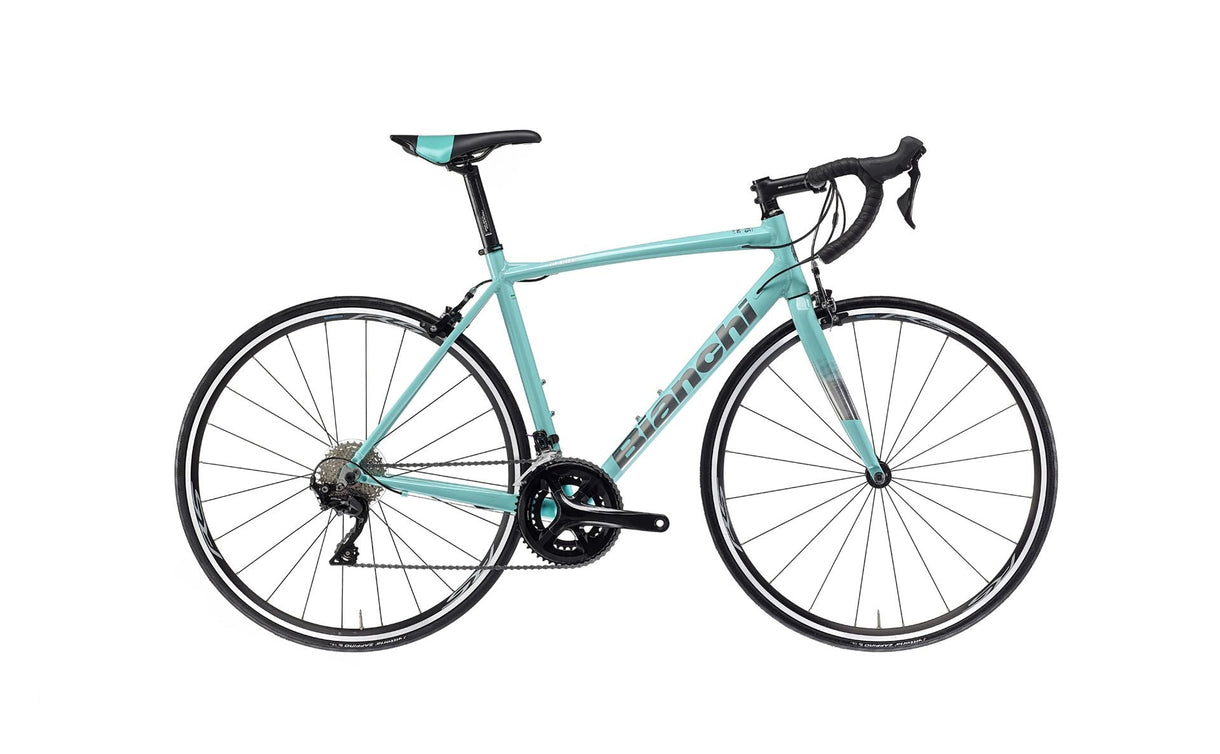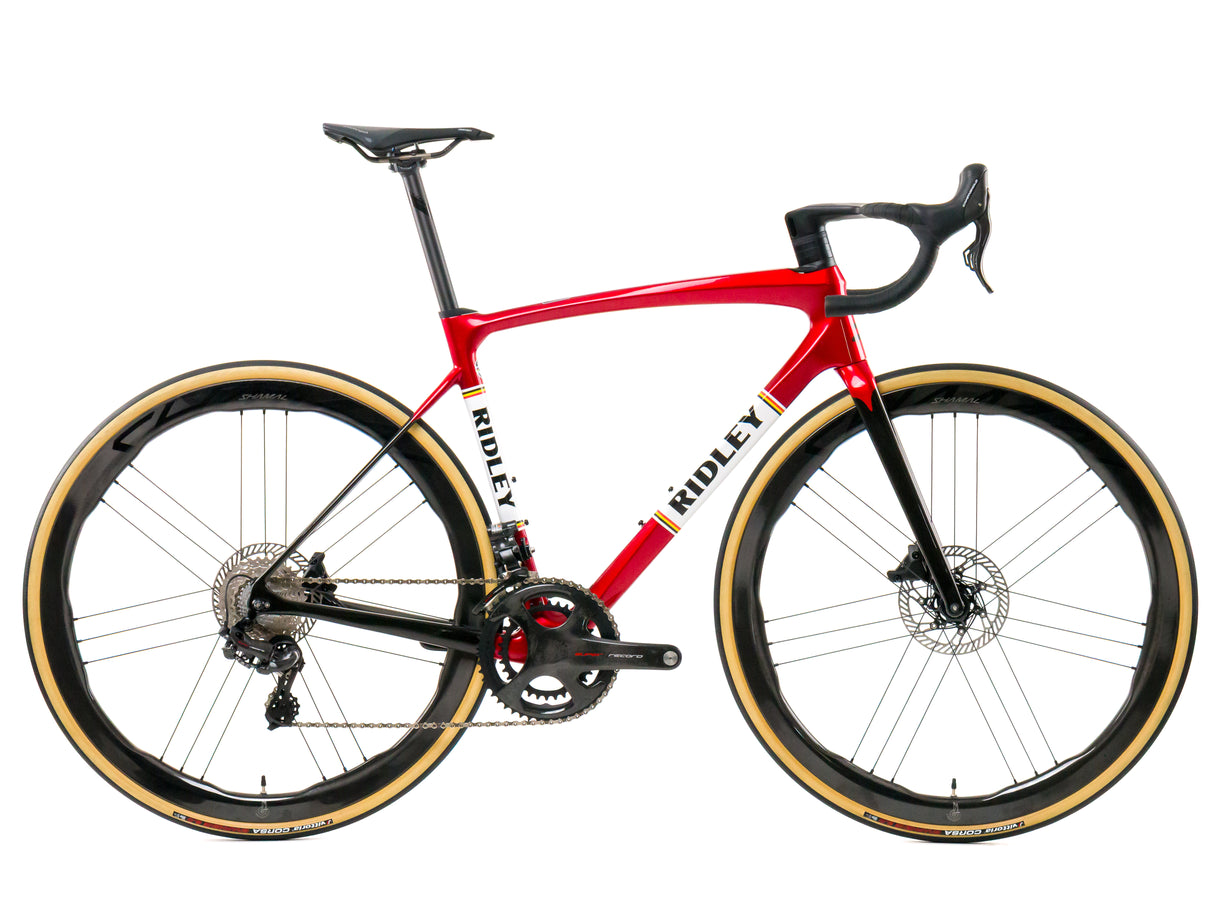In road cycling and triathlon, the choice between aluminum and carbon wheels can significantly impact an athlete's performance. Aluminum rims, known for their durability and reliability, offer greater impact resistance and superior heat dissipation during braking, making them the ideal choice for those prioritizing longevity and safety.
On the other hand, carbon wheels deliver faster acceleration and enhanced aerodynamic efficiency thanks to their superior lightness and stiffness—crucial features for riders aiming for peak performance in both training and competition. However, carbon rims tend to be less impact-resistant and require more careful maintenance.
Ultimately, the decision between the two materials depends on the rider's specific needs and intended use. Let’s dive into the pros and cons of both wheel types to help you make the best choice.

Fulcrum Aluminum Wheel & Vision Metron 81 SL Carbon Wheel
Aluminum Wheels: Pros and Cons
Nel ciclismo professionistico le ruote con cerchi in alluminio non vengono più utilizzate, ma tra gli amatori sono ancora molto comuni perché rappresentano una garanzia di sicurezza elevata ad un prezzo accessibile. Questo non significa che una ruota in alluminio sia meno performante di quella in carbonio. Anzi, i cerchi di alta gamma in alluminio sono un ottimo compromesso tra qualità e robustezza. Ma quali sono pro e contro delle ruote in alluminio. Vediamoli nel dettaglio.
In professional cycling, aluminum-rimmed wheels are no longer in use, but among amateur riders, they remain a popular choice due to their high level of safety and affordability. This doesn't mean that aluminum wheels are inherently less performant than carbon ones. In fact, high-end aluminum rims offer an excellent balance between quality and durability. But what are the real pros and cons of aluminum wheels? Let’s break them down in detail.
Advantages of Aluminum Wheels
-
Reliable in Wet Conditions. Aluminum rims ensure consistently reliable braking, even in the rain. While the advent of disc brakes has mitigated braking issues for carbon wheels, aluminum brake tracks remain the best option for riders using traditional rim brakes, providing powerful and easily modulated braking;
-
No Issues in Windy Conditions. Due to their weight, aluminum wheels typically have a low-profile rim design, making them more stable and less affected by crosswinds. In contrast, high-profile carbon wheels can be more susceptible to wind gusts. Additionally, manufacturers prioritize stability and safety in entry-level aluminum models by incorporating higher spoke counts and slightly heavier builds, making them more comfortable and easier to handle—especially on descents;
-
Affordable Pricing. Aluminum wheels are significantly more cost-effective than their carbon counterparts. They are ideal for training or as a secondary wheelset (if you already own carbon wheels), allowing you to preserve your carbon wheels for better conditions and smoother roads. Most mid-range complete bikes come equipped with mid-tier aluminum wheels as standard;
- Virtually Indestructible. The materials used and the lack of an extreme focus on weight reduction make aluminum wheels highly durable. With proper maintenance, they can last for years. Additionally, if a spoke bends or breaks due to a crash, aluminum wheels—unlike carbon ones—won’t compromise your ability to get home safely.

Fulcrum Aluminum Rim
Disadvantages of Aluminum Wheels
-
Higher Weight. The materials used in aluminum wheels make them heavier than their carbon counterparts. While high-end aluminum models offer improved performance, if you love long climbs and prioritize speed, investing in a lightweight carbon wheelset would be a better choice;
-
Aerodynamics. Aluminum wheels are significantly less aerodynamic compared to carbon wheels, which provide noticeable benefits only at speeds above 30-35 km/h. For non-competitive riders, skipping high-profile carbon wheels isn’t a big sacrifice. However, for those racing on flat courses, low- to mid-profile aluminum wheels will be the least efficient option;
- Aesthetics. There's no denying it—aluminum wheels are less visually appealing than their carbon rivals, especially in mid- to high-profile designs. While aesthetics matter, they shouldn’t be the primary deciding factor.
Bianchi Via Nirone 7 Rim 2022 with Shimano WH-RS100 Aluminum Wheels.
Carbon Wheels: Pros and Cons
If you're seriously considering buying a pair of carbon wheels, you should know that they significantly impact your riding experience first and performance second. In recent years, carbon wheels have surged in popularity. But are they really only suitable for professional cyclists or highly experienced amateurs?
Among professional riders, carbon wheels have long replaced aluminum ones. Just consider the "massive technological leap" that has taken place. Today, it's common to see carbon wheels flying over the cobblestones of Paris-Roubaix and the Tour of Flanders. Manufacturers have successfully addressed past issues related to braking and durability. Moreover, the market now offers more affordable carbon wheel options, making them increasingly accessible to amateur cyclists. But are they the right choice for you? Let’s break down the pros and cons of carbon wheels.
Advantages of Carbon Wheels
-
Aerodynamics. Aerodynamic advantages are one of the main reasons many cyclists switch to carbon wheels. Extensive wind tunnel testing by manufacturers consistently shows that carbon rims experience less air resistance compared to aluminum ones. If you compete in time trials or road races, the benefits of deep-section carbon wheels are undeniable, especially at high speeds. Thanks to their flywheel effect, high-profile carbon wheels help maintain momentum more efficiently;
-
Lightweight. A high-profile aluminum wheelset would be extremely heavy, whereas carbon fiber is significantly lighter, making it ideal for aerodynamic tubeless or tubular wheels. Additionally, the stiffness-to-weight ratio is far superior. Some ultralight carbon wheelsets weigh less than 1 kg, making them the perfect choice for climbers looking to build an ultra-light bike. Naturally, lower-profile wheels are lighter than deep-section ones but offer less aerodynamic advantage. Choosing the right option depends entirely on your riding style and intended use;
-
Performance & Ride Quality. A high-quality carbon wheelset can completely transform the feel of a bike. Carbon wheels are stiffer than aluminum ones, making them the ideal choice for powerful riders who need explosiveness in sprints and quick accelerations. The added stiffness also improves responsiveness when riding out of the saddle. Additionally, some carbon wheels even enhance comfort on rough roads by better absorbing vibrations;
- Accattivanti. Let's not forget the visual appeal. Carbon wheels—especially deep-section ones—give any bike a "Pro-level" look. Installing a sleek set of carbon wheels is often enough to immediately feel and see the difference.

Vision Metron 81 SL Carbon Wheel
Disadvantages of Carbon Wheels
-
Braking Performance. The first carbon wheels had poor braking performance, but most of those issues have now been resolved. The main problem was heat buildup—friction caused the rim to overheat unevenly, leading to inconsistent braking. Manufacturers have addressed this by developing better resins for bonding carbon fibers and improving brake pad compounds. However, aluminum rims still outperform carbon ones in braking, especially in wet conditions, where stopping power and modulation remain superior;
-
Weight. While tubular carbon wheels are incredibly light, more common and budget-friendly clincher carbon wheels tend to be heavier—often comparable to aluminum wheels. However, aerodynamics play a crucial role here: a high-profile aluminum wheelset would be unreasonably heavy, making it not a viable option. If you're looking for lightweight wheels at a lower price and don’t prioritize aerodynamics, then high-end aluminum wheels remain the better choice;
-
Aerodynamics. Manufacturers put a strong emphasis on the aerodynamic advantages of carbon wheels, often showcasing wind tunnel data to support their claims. However, real-world conditions differ significantly from a controlled wind tunnel environment. Factors like tire width, frame design, and crosswinds all impact actual aerodynamic performance. Deep-section wheels can also become unstable in crosswinds, especially for lighter riders. This is why mid-depth rims (30mm) have gained popularity, offering a balance between stability and aero gains;
-
Durability. Carbon is an incredible material, and carbon fiber wheels are remarkably strong. Unlike aluminum, they don’t bend—but that also means they’re more susceptible to impact damage. If an aluminum rim bends, it can often be trued to get you home. In contrast, a damaged carbon rim is usually unusable, potentially creating a safety hazard. Carbon wheels are not designed to handle excessive loads or sudden impacts, making them more fragile than their aluminum counterparts;
- Cost. Carbon wheels are anything but cheap. While prices have become more accessible in recent years, they still don’t match the affordability of aluminum wheels. If you're on a budget, a high-quality aluminum wheelset will still offer great performance at a fraction of the cost.
Ridley Fenix SLiC 2024 with Campagnolo Shamal Dual Carbon Wheels.
Choosing Between Aluminum and Carbon Wheels: A Quick Recap
To sum up, carbon wheels are undeniably more performant than aluminum ones. They offer numerous advantages, and you don’t need to be a professional to ride them. However, they require some experience to handle properly. If your goal is to compete at a high level, carbon wheels—whether high, mid, or low profile, depending on the race—are a must-have.
That said, even for competitive riders, it can be wise to own an aluminum wheelset. Carbon wheels are more delicate, and you don't want to risk damaging your best set in harsh weather or on rough roads.
On the other hand, if you prioritize durability over aerodynamics and weight, aluminum wheels are the better choice. Opting for aluminum doesn’t mean settling for low-quality wheels—it simply means choosing a more robust and cost-effective solution that carbon can’t always guarantee. Aluminum is also the best option for beginners, as it’s more stable, affordable, and safer. If you're new to cycling, it’s better to gain experience before investing in carbon wheels.



































































































